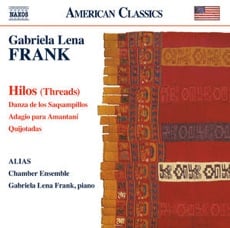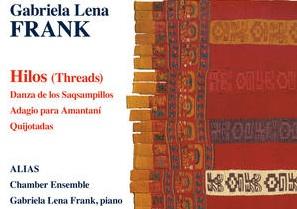
Some new compositions are designed to be treated as major events. They are, naturally, all big ones. Usually they are for large ensemble, occasionally for a chamber grouping or a solo instrument (though in that case they’re required to be long, stultifyingly difficult, or both). It’s well to remember that music doesn’t have to be on an epic scale to reward attention.
Gabriela Lena Frank, on the evidence of a new Naxos recording of four chamber works, is a magnificent miniaturist, a master of quick and vivid sketches. Born in Berkeley to a Peruvian-Chinese mother and a Lithuanian-Jewish father, she draws heavily on the Peruvian side of that heritage in the pieces here.
The largest — and most recent — work on the program is Hilos (Threads), a 2010 work written for the Nashville-based ALIAS ensemble, which (with the composer as pianist) performs it here. It’s scored for piano, clarinet, violin, and cello, like Messiaen’s Quartet for the End of Time,, and, also like that work, includes movements for less than the full quartet. Indeed, only the first and last of the eight short movements of Hilos involve all four players.
Listen To The Music
Hilos (Threads) 2. Zapatos De ChinchaQuijotadas 2. Seguidilla Para La Mancha
Purchase Recording


A portion of each purchase helps
support San Francisco Classical Voice
Frank writes that the work’s title refers both to the colorful textiles of Peru and to the “threads” of Peruvian culture that the individual movements represent. Color there certainly is, in abundance; Frank has a knack for delightful character pieces. Several movements in Hilos are in this vein, like the clarinet-and-cello “Zapatos de Chincha” (Shoes of Chinca, a Peruvian coastal town that Frank writes is renowned for, among other things, a kind of tap dance), the clarinet-and-piano “Zumbayllu” (a depiction of a child’s spinning top), and the clarinet/violin/cello “Juegos” (Games), which the composer aptly styles a “romp.”
The movements without the clarinet have a darker cast. Frank uses tremolo to simulate the raspy harshness of a Peruvian folk singer’s voice. In “Charanguista Viejo” (Old charango player — the charango is an instrument something like a ukulele, made out of the outer armor of an armadillo), that effect is combined with a violin part that, its opening pizzicato section apart, lies entirely on the lowest string, yet ranges very high. Violinists will be reminded of Ravel’s Tzigane, but the style here, though as rhapsodic as the Ravel, is quite different, and this violin oration is punctuated by bright splashes of color from the piano.
The movements for the full ensemble are different again. The opening “Danza del Altiplano” (Dance of the Highlands) has almost a klezmer feel, largely because of the keening clarinet, while the finale is an extended dance full of hemiolas and other cross-rhythms. (The title of that one is “Bombines” — literally, “bowler hats,” — and Frank writes that it is “in homage to the ubiquitous bowler hats worn by mountain women” in Peru.)
The other big piece here is the 2007 Quijotades, a string quartet based on the adventures of Miguel de Cervantes’ celebrated Don Quixote. Bay Area listeners have had at least one opportunity to hear this engaging score before. I remain as taken with it as I was then; Frank writes for quartet with engaging ease and an ear for striking textural possibilities. Here again, she doesn’t use the entire ensemble all the time, though, apart from the opening movement (for the two violins alone), each movement eventually involves all four players.
In between these two works on the CD come two smaller ones. Danza de los Saqsampillos (Dance of the Saqsampillos — a saqsampillo, Frank helpfully glosses for us, is “a rambunctious jungle-dweller”), for two marimbas, is a 2006 arrangement of a movement of an earlier work for solo piano. It’s a brilliant toccata, again full of hemiolas and other rhythmic hijinks. To me, as listener, it seems to go on a shade too long for its own good, but I doubt I’d think that if I were a mallet player; it must be wicked fun to perform.
The 2007 Adagio para Amantaní (Amantaní is an island in the middle of Lake Titicaca), for cello and piano, is, at nearly 10 minutes’ length, much the longest continuous stretch of music on the disc. Here again I’m not sure the material sustains the length of the piece, though as a depiction of what Frank describes as a harsh and barren environment its starkness of rhetoric is apt.
The performances, all by members of ALIAS (with the composer as pianist), are uniformly excellent, as is the recorded sound.

